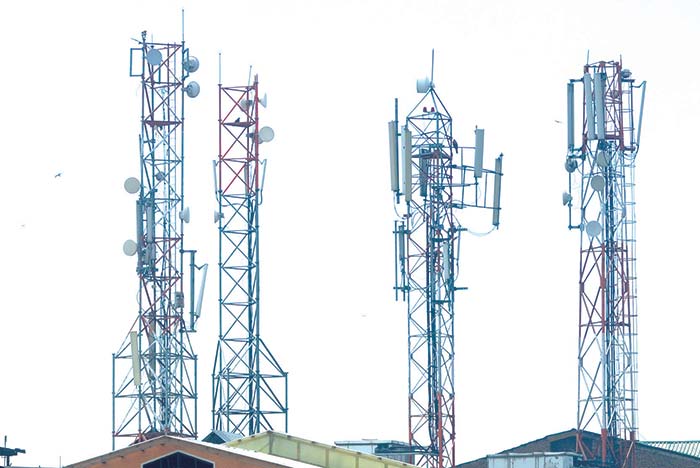As otherwise abundant bird species get rare in the cities, experts hold electromagnetic radiation responsible for the mess. The faster communication technologies will add to the stress of the birds and impact an ecological balance, reports Umaima Reshi

With the 5G already becoming popular, the debate about its possible impact on different life forms is back to the table talk. There are reports that bird populations are getting impacted by the radiations emitted by the base tower stations (BTS), a key infrastructure for all kinds of mobile telephony.
BTS is vital in communication. It is an electromagnetic device with pernicious radiation. It is a fixed transceiver in all mobile networks, which connects mobile devices to the network. It sends and receives radio signals to mobile devices and converts them to digital signals. Besides, it passes on the network to route to other terminals in the network or to the internet. The quantum of radiation depends on the number of sensors installed on a BTS. Its power potency changes with distance.
The BTS Networks
Electromagnetic fields and radiations are usually pervasive. People already live with a variety of electromagnetic radiations that power the radio, television, and cell phones. Unlike all others, however, BTS are the major sources of electromagnetic field and radiation in any environment. Cell phone technologies have densities mostly between 800MHz and 3GHz and BTS antennae have a frequency of 900 or 1800MHz, pulsed at low densities, generally known as microwaves (300MHz–300GHz). The use of cell phones has helped in the spread of BTS and it has converted most of the space into an electromagnetic field immensely.

Unlike all earlier BTS, the ones used for the 5G network are reportedly impacting the ecology more. The 5G network emanates high-density signals on the scale of 30 GHz to 300 GHz. This is being seen as the source-adverse impact on the surrounding. In an appeal to the European Union, 180 scientists and doctors from 36 countries warned that there are assuredly legitimate concerns regarding the 5G technology.
Birds Hit
In comparison to humans, birds have a considerable body-to-weight ratio, which is why they captivate more radiation. The liquid form, like blood, platelets, and plasma in the anatomy of a bird is subordinate, and so it turns feverish promptly. Magnetic exposure from the tower hinders the navigation skills of the birds. When birds are exposed to EMR; they get adrift and muddled and start to fly erratically. Besides, a copious number of birds succumb due to clashes with telecommunication masts, annually.
The diversity of bird species is said to be at risk due to various causes including strong electromagnetic fields. In Kashmir, many bird species like sparrows, pigeons, and swans are gradually disappearing from the cities and many people link it to the strong electromagnetic fields around.
According to the Cellular Operators Association of India (COAI) report of 2016, specifically, 16764 BTS are installed at 8554 sites across Jammu and Kashmir. In Kashmirm there are 4000 Base transceiver stations (BTS), increasing with the number of users.
The Lolab Survey
Attempts were made to understand the repercussions of mobile tower radiation on birds at different sites and villages of Lolab Valley in Kupwara in 2019. It was jointly carried out by zoology scholars of Dr CV Raman University, Kota Bilaspur – Tawseef Ahmad Bhat, and Dr R K Singh.
In the course of the evaluation, a sum total of 17 groups of birds were listed at particular sites. The number of birds documented within a 200-meter radius of the mobile tower was comparably less than that embarked exterior to a 200-meter radius.
The survey suggested that the birds are afflicted more within this range as the expanse and reverberations of electromagnetic radiations effused by mobile towers are inversely correlated to the stretch from the tower as per ICNIRP (International Commission on Non-Ionizing Radiation Protection).
The birds that were found within as well as outside the radius of different sites were Common Myna, Rock Pigeon, Steppe Eagle, House Sparrow, Jungle Crow, and Eurasian Jackdaw. The distribution of birds outside the radius included Slatyheaded Parakeet, Grey Bushchat, Eurasian Hoopoe, European Turtle Dove, Himalayan Bulbul, Yellow-billed Magpie, Himalayan Woodpecker, White Wagtail, Spotted Forktail, and Phimbeous.
Radiations from cellular towers cause exasperation among the birds; making them depart to other areas where the impact of radiation is low, which layouts a signal for their disappearance from towns. The survey concluded that birds are highly affected by electromagnetic radiation. “Behaviour of birds may be changed when exposed to such radiations. They may lose the power of orientation, natural navigation and fly in any direction,” it said.

“The electromagnetic radiation grimly affects the generative achievement of birds due to which the conceiving success is reduced. Contemporary scientific testaments reveal that protracted vulnerability to electromagnetic radiation can also strike immune system activity. Magnetic fields can impact the advancement and occurrence of deformities in the fertilization of embryos and at the same time, an agitated immune system also escalates the proneness of birds to ill effects and diseases,” one of the avian fauna veterinarians said. “Feather loss is the very first ailment of deteriorating health in birds. There are many other symptoms and susceptibility to radiation because the exposure depends upon genetics and the physical condition of the impacted creatures.”
10 Species
The depletion of ten species of avian fauna, commonly found in the city was recorded. The situation was quite the same in the consolidated areas of the territory. Now they are nowhere to be seen. The vanishing of house sparrows and crows has been majorly reported. The cause behind that is microwaves (300 MHz to 300 GHz) emitted by cell phone towers and handsets, are damaging eggs and embryos of sparrows.
Though the Telecommunication industry has introduced protective guidance for human beings vulnerable to wireless radiation; there is no analogous protective clue for living organisms.














